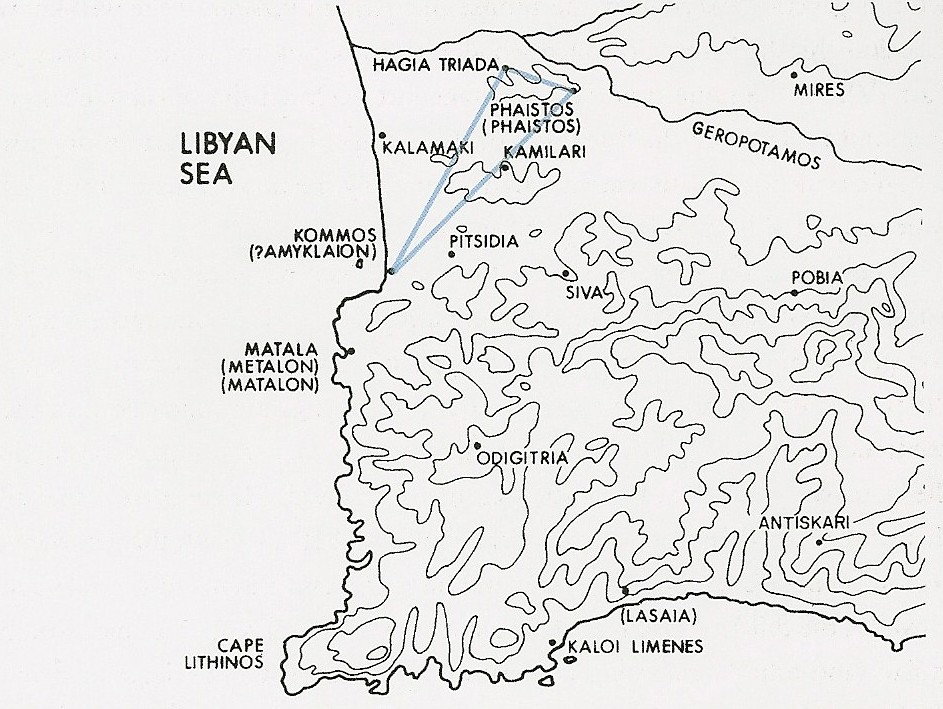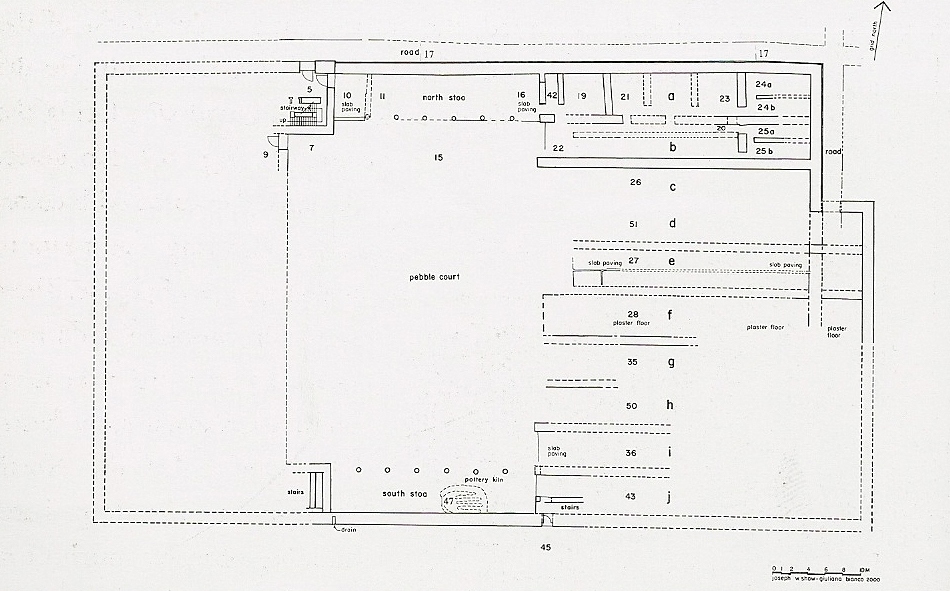Past Minoan Triangle
In South Central Crete: Kommos, Agia Triada, Phaistos
A Great Minoan Triangle – past (Greek language pdf version)
A connection in the past
In 1985, 10 years into Joseph and Maria Shaws’ excavation at Kommos, the excavators convened a symposium of a group of experts to discuss fitting Kommos into a regional context of the western Mesara. The symposium also considered the recent finding of a large, one could say monumental building and its use, as postulated by Maria Shaw as a Minoan era ship shed. The title of the forum “A Great Minoan Triangle in South Central Crete” was based on the three major pre-historical sites of Phaistos, Hagia Triada and Kommos.
Excavation Director Joseph W. Shaw provided the forum
Introduction:

Professor L. Vance Watrous a leading expert in Minoan pottery gave the paper below titled:
Late Bronze Age Kommos: Imported Pottery as Evidence for Foreign Contact
The Kommos styles of pottery were initially influenced by Phaistos and Knossos and then during MMII (ca.1900BC) the Phaistos style alone became dominant. In MMIII (ca.1700BC) pottery from Kommos displays parallels with pottery from other sites in the Mesara, such as Kamilari, Chalara, Agia Triada and once more stylistic similarities with the Knossos specific to the temple repository. During this MMIII period , influences outside of Crete are also found in the archaeological pottery record for Kommos. Similarities with Kythera and Agia Eirene on Kea were discovered, and there are fragments from the Cyclades suggesting trade both north and east of Crete. The MMIII period also finds imports from Aigina and mainland Greece. In MMIII and LMIA (ca.1600BC) influences from are found from eastern Crete, such as was common at Zakros.
 |
 |
 |
The second speaker, Assistant Excavation Director Maria C. Shaw gave the paper below titled:
MM II & MMIII Building T of palatial proportions (62m x 40m) contained two opposed columned stoas (the northen stoa is under Greek Temple A2 ) and on the north abutted a slightly earlier structure(building J) with a staircase to a second story. This structure also contains pier and door partitions associated with the elite houses and palaces that are rare at Kommos but can be found at Phaistos and Hagia Triada. The author’s Notes and the questions and discussion between Professor Maria Shaw, Joseph Shaw, Michael Katsev, Gerry Sheppard, Jennifer Moody and Guenter Kopcke are also included.
Another paper by another leading expert professor Phillip P. Betancourt also published in Scripta Mediterranea, Vol. VI (1985) and linked below, is titled:
The Changing Character of Phaistos, Hagia Triada and Kommos During the Middle Minoan IB- Late Minoan III Periods
In the paper professor Betancourt explains :
Phaistos and Kommos were already settled by the end of the Neolithic period. By the early bronze age Hagia Triada was also settled as supported by tholos tombs (Banti 1930-31) Within the period EMIII/MMI, coastal settlements are expanded, palaces are built or enlarged, and many new villages are built or enlarged. In the Mesara, there is evidence for either an increase or a redistribution of population. Some old sites are expanded, and many new ones are founded. Later Phaistos declined and Hagia Triada and Kommos grew contemporaneous with change and influential growth associated with Knossos.
Betancourt provokes consideration from forum attendees consideration with the following questions:
• Where did the increase in population in MM IB come from?
• Where did the population go in LM IIIB?
• If Kommos was a port by MM I, what does that imply about the specialization of the Cretan Economy by this period?
• Could a town exist without being an agricultural center?
• How can Kommos have been raised to importance as a port if the quantity of imports only becomes large in the late Bronze Age, well after it was already a significant town?
• If Kommos was the harbor town for the Messara during much of the second millennium B.C., should it be regarded a dependency of Phaistos until the end of LM IB and a dependency of Hagia Triada during LM II-III?
• Can it have been a palace in its own right during LMI, perhaps subservient to Phaistos, but drawing its wealth from the rich grazing lands to the south and from the many small fertile plots in the hills south of the Messara?
Questions and comments from Joseph Shaw, Geraldine Gesell, Guenter Kopcke, Elizabeth Barber, Vance Watrous, Jennifer Moody, Dick Hope Simpson and Roger McCleary follow the paper presentation.
 |
 |
|---|
Professor Joseph Shaw’s 1985 forum
credits the important research of Vincenzo la Rosa at Phaistos and Hagia Triada and his conclusion that during the period in pre-history discussed, there was a peaceful transfer of power from Phaistos to Hagia Triada and that Kommos served as their seaport. Professor Shaw concludes with a statement that
the most important aspect of the conference was to introduce consideration of the Messara s dynamics during some eight hundred years of its history.
There are author’s notes and a bibliography included after the epilogue, as well.
The Great Minoan Triangle forum on the international trade of goods presages the importance of the three western Mesara Minoan archaeological sites importance to the local economy today. We have posted in our blog the interpretive educational value of the Kommos artifact collection and the impressive scholarship from Kommos Conservancy officers Maria and Joseph Shaw with contribution from Professor L. Vance Watrous and many others. Developing the Kommos archaeological site for heritage tourism should connect the future archaeological park to the other two related archaeological park experiences, currently in operation at Phaistos and Hagia Triada, establishing a future Minoan triangle, that can provide a sustainable tourism based economic benefit to the adjacent towns in the Mesara valley.



0 Comments on “Past Minoan Triangle”